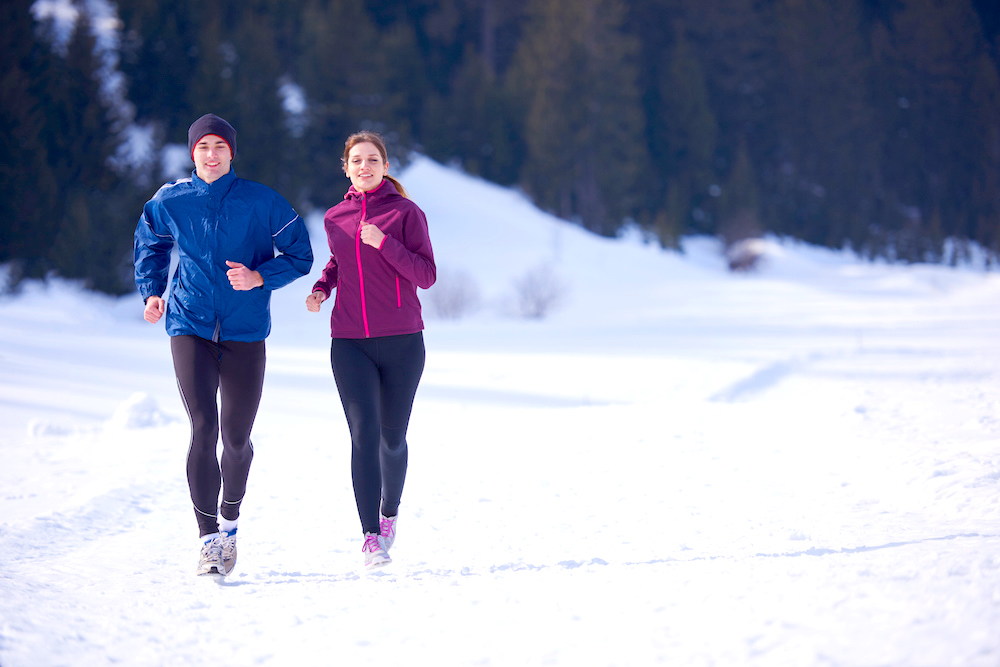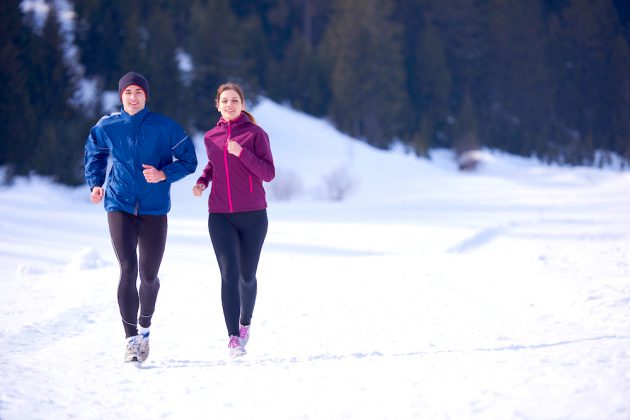By Joscelyne Hauserman
For some, the idea of running in cold weather can be daunting. Others may enjoy the idea— seeing it as a great time to earn a new PR or let off steam (literally). Whether you fall into the first category or the second, one thing is for certain: you’ve got to be smart about it. Follow these tips and you could be on your way to finding a new favorite running season.
Finding Motivation
Let’s face it— the feeling of icy air filling your lungs after that first step outside is not happily anticipated. This experience alone is enough to make many say “No thanks, I’ll pass!” when a winter run is brought to mind. The good news is, even though the initial few breaths may be a little intense, your body adjusts quickly. It only takes about a minute or less for your body to adapt— so don’t give up too quickly if that’s what bothers you most.
Still not feeling the “go for it” attitude? Try planning a running date with a friend. The old adage “misery loves company” can be especially true when it comes to running in cold temps. Not only will running with a friend help distract you from the frigid air, it can make your run safer. Imagine if you were to slip on ice or space out and not see a vehicle coming your way—having another person there to look out for you could potentially save your life (or at least a twisted ankle).
Got a case of the “winter doldrums?” Both exercise and being outside are great ways to battle Seasonal Affective Disorder (SAD). Next time the shorter days and dreary skies have you feeling down, consider going for a brisk run on your favorite route. It may help more than you would think.
What to Wear
Believe it or not, it really doesn’t take much to stay warm during a cold-weather run. After speaking with many runners from my hometown in north-central Pennsylvania (where the winters get well below zero degrees), I have gathered that the rule of thumb is to “dress like it’s 15-20 degrees warmer than it actually is.” The reason for this: once you get about a mile into your run, your body heats up well beyond the temperature needed to feel comfortably warm. In fact, if you dress too heavy, you may run the risk of overheating or sweating so much it starts to freeze you when it comes in contact with the wind. Neither of those outcomes feel good and both can seriously jeopardize your safety. Here are some tips for how to dress:
25 to 35 degrees: long sleeve base-layer or half zip, and a vest to keep your core warm. For bottoms—tights or track pants are fine. My favorite pick: Brooks LSD Thermal Vest
10 to 25 degrees: long sleeve base-layer or half zip with a wind-breaking jacket over top. You also want to make sure you have a good pair of technical mittens/gloves and a hat/ear muffs. For bottoms—insulated tights with wind-breaking pants over top. My favorite pick: Mizuno Breath Thermo Seamless Half-Zip (the Breath Thermo line heats up when it comes in contact with moisture—aka your sweat!)
Now about your feet. If you’re planning on running in slush or snow, running shoes with a mesh upper may not be the best choice. If you are able, buy a pair of shoes with a waterproof or Gore-Tex upper to prevent getting your feet wet. If that’s not an option, avoid running outside in conditions where your feet are likely to get very wet—otherwise they may freeze, which could potentially cause tissue damage.
As for socks, wool is the best choice for cold-weather running. Wool naturally regulates body temperature—keeping your feet warm, not hot. It’s also naturally anti-microbial (for less stinky feet) and wicks away moisture better than most synthetics (sayonara, sweat!). Afraid it might be too itchy? There are many brands of wool socks so soft you’ll swear you were wearing kittens on your feet. Keep an eye out for merino and mohair blends—they’re the best.
Before Your Run
It is essential that you warm up before you run, and I don’t just mean a typical warm-up stretch. In addition to dynamic/active stretching, you want to make sure that you get your heart beating at an elevated rate before you begin outside. This will slightly increase your body temperature, which will make the cold much more bearable and give you a nice energy rush to start your run. Try jogging in place for a few minutes or doing a couple burpees if you are uncertain how to start.
After Your Run
It is very important that you change clothes after your run. As soon as you stop running, your core body temperature drops, and wearing sweaty, wet clothing may increase this temperature drop to a dangerous level. Pack an extra pair of warm clothes (especially sports bras, ladies) if you don’t plan on going home immediately after your run. You may also want to pack a thermos of hot tea or cocoa, as it will help heat you up from the inside out.
One last thought: it’s good to push boundaries, but only when you know for certain that you can safely handle it. Running in the winter can be great, but can be dangerous. Never run outside if there is a severe weather/temperature advisory or if conditions are really bad. Wear reflective clothing and/or a head-lamp if running in the dark. If temperatures are below freezing, stay alert for “black ice,” or spots where the pavement looks dry but is covered with a thin, slippery layer of ice.
Happy running!
# # #
Joscelyne Hauserman recently moved to Charlotte from central Pennsylvania. She graduated from Penn State University with a Bachelor’s of Science in Marketing and a minor in Communications. She lives in Ballantyne with her boyfriend, Steve, and cat, Juniper. Joscelyne loves running, climbing, and anything outdoors!








